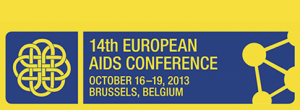Caution against prolonged use of bisphosphonates in patients with mild-moderate fracture risk
1 December 2013. Related: Conference reports, Coinfections and complications, EACS 14 Brussels 2013.
 Simon Collins, HIV i-Base
Simon Collins, HIV i-Base
A useful overview of advances in the prevention and management of osteoporosis was presented by Todd Brown from Johns Hopkins School of Medicine. [1]
This included focusing on the absolute risk of fracture, the benefits and risks of bisphosphonate therapy and new strategies for fracture risk reduction with reference to both US National Osteoporosis Foundation (NOF) guidelines and those from the International Osteoporosis Foundation (IOF).
A new focus on the absolute risk of fracture has changed the way that osteoporosis is now treated in the US.
In 2003, US (NOF) guidelines recommended screening all women older than 65, younger women with one of more risk factors and postmenopausal women who present with a fracture. Lifelong alendronate treatment was recommended if DEXA T-score was -2.0 in absence of other risk factors, at -1.5 with one or more risk factors and for anyone with a prior vertebral or hip fracture.
By contrast, 2003 IOF guidelines required risk factors and a fracture for screening with treatment only recommended if T-score was -2.5 or lower.
Although osteoporosis is defined as a systemic skeletal disorder characterised by low bone mineral density (BMD) and a microarchitectual deterioration of bone tissue which together increase bone fragility and the risk of fracture, DEXA only identifes BMD.
As both bone quality and risk of falls are as important when assessing risk of fracture, T-score is now interpreted due to these underlying risks. A T-score of -2.5 will present a different risk, for example, for someone who is 80 years old compared to someone who is 50. Guidelines, including EACS and BHIVA, focus on those at highest risk, using the FRAX equation (www.sheff.ac.uk/FRAX).
NOF guidelines revised in 2013 now recommend treatment for patients with T-score between -1.0 and -2.5 when 10 years FRAX score is >3% for hip fracture or when FRAX is >20% for all osteoporosis related fractures.
IOF 2012 guidelines use FRAX slightly differently based on fracture probability prior to DEXA results.
Treatment changes since 2003 include no longer using estrogen/hormone therapy to reduce fracture risk or calcitonin (due to carcinogenic risk and poor efficacy).
In 2003, treatment using oral bisphosphonates (risedronate, alendronate, ibandronate) to inhibit osteoclast activity was generally lifelong. Since then, zolendronic acid injections have been approved as a new option. However, oversuppression of bone turnover is associated with long-term risks that include osteonecrosis of the jaw (ONJ) and spontaneous or minimal trauma atypical femur fractures that are often bilateral. Although the incidence for these complications are not precisely known, both are categorised as rare, although the risk increases with duration of bisphosphonate use.
This has lead to a recommendation (based on very limited data) to stop bisphosphate treatment in some patients based on their fracture risk.
Continuous treatment is still recommended for those at high risk, interrupting treatment (risedronate, alendronate and zolendronic acid) after 3-5 years is recommended for those at moderate risk, and permanently discontinuing treatment is recommended for those now defined as low risk. There is no data on use of ibandronate or on duration of the treatment break and how to monitor. [2]
New treatments include teriparatide (Forteo) which promote bone formation but which is only indicated for patients who have continued bone loss or fracture on bisphosphonates. Teriparatide is given by daily injection for 12-24 months. However, increases in bone density are rapidly lost if antiresorptive drugs are not used.
The monoclonal antibody denosumab (given twice yearly) reduces risk of spine or hip fracture by antiresorptive mechanism on osteoclasts but carry similar safety concerns to bisphosphonates due to oversuppression of bone turnover, with a possibly increased risk of infection that may require further study for use in HIV positive patients. [3, 4]
Anabolic drugs in the pipeline include scelrostin antibodies and antiresorptives including cathepsin K inhibitors that promotes bone formation.
Research that focuses on muscle and physical function is also likely to impact on future fracture risk.
References:
- Brown T. Recent advances in the prevention and management of osteoporosis. 14th EACS, 2013. Mini-lecture ML3. Webcast:
http://www.multiwebcast.com/eacs/2013/14th/39187/todd.brown.ml3.prevention.and.management.of.osteoporosis.html - McClung M et al. Bisphosphonate therapy for osteoporosis: benefits, risks, and drug holiday. American Journal of Medicine, 2013. 126 (1); 13-20, (January 2013). doi:10.1016/j.amjmed.2012.06.023.
http://www.amjmed.com/article/S0002-9343(12)00587-6/abstract - Cummings SR et al. Denosumab for prevention of fractures in postmenopausal women with osteoporosis. N Engl J Med 2009;361:756-65. (20 August 2009).
http://www.nejm.org/doi/full/10.1056/NEJMoa0809493 - Tsai JN et al. Teriparatide and denosumab, alone or combined, in women with postmenopausal osteoporosis: the DATA study randomised trial. Lancet 382 (9886): 50-56 (6 July 2013). doi:10.1016/S0140-6736(13)60856-9.
http://www.thelancet.com/journals/lancet/article/PIIS0140-6736(13)60856-9/abstract
